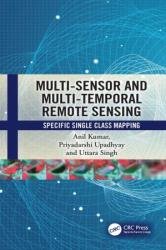 Название: MultiSensor and MultiTemporal Remote Sensing
Название: MultiSensor and MultiTemporal Remote SensingАвтор: Anil Kumar, Priyadarshi Upadhyay, Uttara Singh
Издательство: CRC Press
Год: 2023
Страниц: 178
Язык: английский
Формат: pdf (true)
Размер: 10.2 MB
This book elaborates fuzzy Machine Learning and Deep Learning models for single class mapping from multi-sensor, multi-temporal remote sensing images while handling mixed pixels and noise. It also covers the ways of pre-processing and spectral dimensionality reduction of temporal data. Further, it discusses the ‘individual sample as mean’ training approach to handle heterogeneity within a class. The appendix section of the book includes case studies such as mapping crop type, forest species, and stubble burnt paddy fields.
There are numerous Machine Learning models available for use in a variety of applications. Machine Learning classifers can fall into statistical categories such as c-Means, maximum-likelihood classifers, and decision-tree categories, such as random forest and Classifcation and Regression Tree (CART). Fuzzy c-Means (FCM), Possibilistic c-Means (PCM), Noise Clustering (NC), and Modifed Possibilistic c-Means (MPCM) are examples of fuzzy-logic algorithms. The Machine Learning model should be chosen in such a way that it can deal with mixed pixels, non-linearity between classes, and noisy pixels. Machine Learning models should be able to map a single class of interest, which has a wide range of applications, where only one class of interest needs to be mapped from remote-sensing data. Machine Learning models should also be able to deal with heterogeneity within classes, which is caused by the fact that training data for each class is not homogeneous. So, in this section, fuzzy classifers are discussed, which addresses the raised concerns. In this chapter, mathematical formulas and algorithms of the fuzzy-based algorithms have been explained. The description starts with Fuzzy c-Means (FCM), moves on to Possibilistic c-Means (PCM) and Noise Clustering, and then Modifed Possibilistic c-Means (MPCM) is described.
Key features:
Focuses on use of multi-sensor, multi-temporal data while handling spectral overlap between classes
Discusses range of fuzzy/deep learning models capable to extract specific single class and separates noise
Describes pre-processing while using spectral, textural, CBSI indices, and back scatter coefficient/Radar Vegetation Index (RVI)
Discusses the role of training data to handle the heterogeneity within a class
Supports multi-sensor and multi-temporal data processing through in-house SMIC software
Includes case studies and practical applications for single class mapping
This book is intended for graduate/postgraduate students, research scholars, and professionals working in environmental, geography, Computer Sciences, remote sensing, geoinformatics, forestry, agriculture, post-disaster, urban transition studies, and other related areas.
Скачать MultiSensor and MultiTemporal Remote Sensing